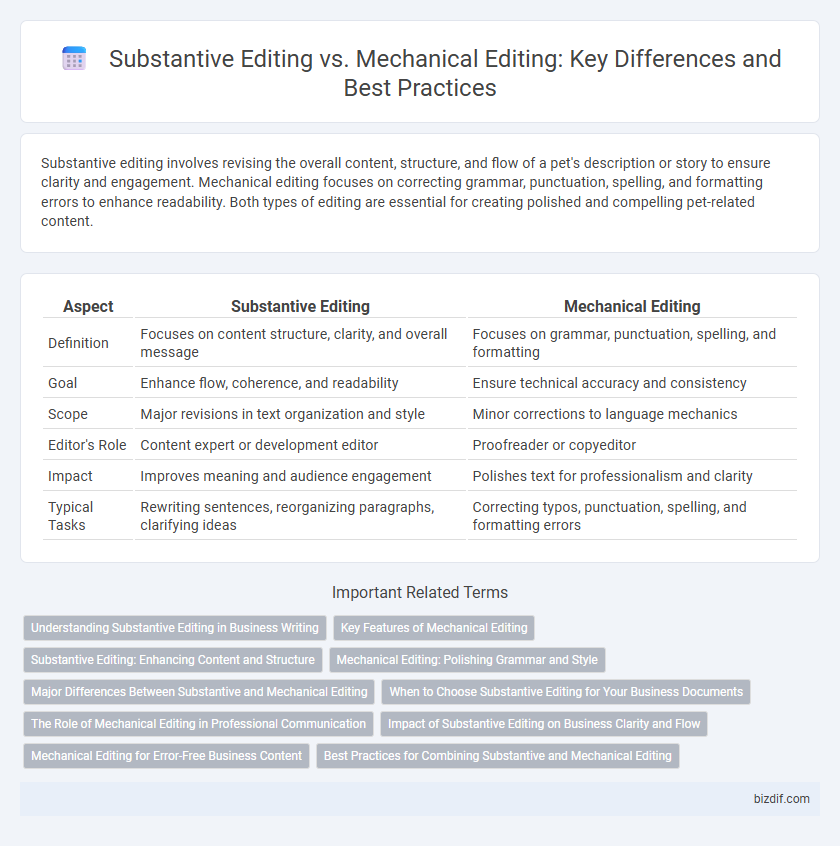Substantive editing involves revising the overall content, structure, and flow of a pet's description or story to ensure clarity and engagement. Mechanical editing focuses on correcting grammar, punctuation, spelling, and formatting errors to enhance readability. Both types of editing are essential for creating polished and compelling pet-related content.
Table of Comparison
| Aspect | Substantive Editing | Mechanical Editing |
|---|---|---|
| Definition | Focuses on content structure, clarity, and overall message | Focuses on grammar, punctuation, spelling, and formatting |
| Goal | Enhance flow, coherence, and readability | Ensure technical accuracy and consistency |
| Scope | Major revisions in text organization and style | Minor corrections to language mechanics |
| Editor's Role | Content expert or development editor | Proofreader or copyeditor |
| Impact | Improves meaning and audience engagement | Polishes text for professionalism and clarity |
| Typical Tasks | Rewriting sentences, reorganizing paragraphs, clarifying ideas | Correcting typos, punctuation, spelling, and formatting errors |
Understanding Substantive Editing in Business Writing
Substantive editing in business writing involves reevaluating the content's structure, clarity, and overall message to ensure it aligns with strategic communication goals. This process emphasizes enhancing ideas, tone, and flow, rather than merely correcting grammar or punctuation, which is the focus of mechanical editing. Mastery of substantive editing leads to more persuasive, coherent, and impactful business documents that drive decision-making and stakeholder engagement.
Key Features of Mechanical Editing
Mechanical editing primarily focuses on correcting spelling, punctuation, grammar, and formatting errors to ensure textual accuracy. It enhances readability by standardizing language conventions and eliminating surface-level mistakes. Key features include attention to syntax, capitalization consistency, and proper use of abbreviations.
Substantive Editing: Enhancing Content and Structure
Substantive editing focuses on enhancing the overall content and structure of a document by improving clarity, coherence, and logical flow. This type of editing addresses issues such as organization, development of ideas, and consistency in tone, making the text more engaging and effective for its intended audience. Unlike mechanical editing, which targets grammar, punctuation, and spelling, substantive editing involves deep revisions that transform the manuscript's message and impact.
Mechanical Editing: Polishing Grammar and Style
Mechanical editing focuses on polishing grammar and style by correcting syntax, punctuation, spelling, and sentence structure to ensure clarity and readability. It enhances consistency in tone, voice, and formatting, aligning the text with established style guides like APA, MLA, or Chicago Manual of Style. This stage refines the draft beyond content accuracy, improving language precision and overall presentation for a professional final manuscript.
Major Differences Between Substantive and Mechanical Editing
Substantive editing focuses on the content, structure, and overall coherence of a text, ensuring clarity, logical flow, and completeness of ideas. Mechanical editing addresses surface-level errors such as grammar, punctuation, spelling, and formatting consistency to enhance readability and professionalism. The major difference lies in substantive editing's emphasis on meaning and organization, while mechanical editing prioritizes technical accuracy and language mechanics.
When to Choose Substantive Editing for Your Business Documents
Substantive editing is essential when your business documents require significant restructuring, clarity enhancement, and consistency improvement to effectively communicate complex ideas. Choose substantive editing when the content needs thorough evaluation for logical flow, tone, and overall message alignment with your brand's goals. This approach ensures that your documents resonate with stakeholders and convey professionalism, unlike mechanical editing, which only corrects grammar, punctuation, and formatting.
The Role of Mechanical Editing in Professional Communication
Mechanical editing ensures correct grammar, punctuation, spelling, and formatting, which are crucial for maintaining clarity and professionalism in written communication. It supports the seamless transmission of ideas by eliminating distractions caused by textual errors and inconsistencies. This type of editing upholds brand integrity and readability, enhancing the overall impact of professional documents.
Impact of Substantive Editing on Business Clarity and Flow
Substantive editing enhances business clarity by restructuring content to improve coherence, ensuring key messages are clearly communicated and easily understood by the target audience. This type of editing focuses on logical flow, eliminating ambiguities, and aligning the tone with the brand's voice, which fosters stronger engagement and credibility. In contrast to mechanical editing that corrects grammar and punctuation, substantive editing directly impacts the effectiveness of business communication and decision-making processes.
Mechanical Editing for Error-Free Business Content
Mechanical editing targets grammatical accuracy, punctuation, spelling, and formatting to ensure error-free business content that upholds professionalism. This precise editing phase eliminates typos, corrects syntax, and standardizes style, which enhances clarity and readability. Businesses benefit from mechanical editing by delivering polished materials that build trust and credibility with clients and stakeholders.
Best Practices for Combining Substantive and Mechanical Editing
Combining substantive and mechanical editing maximizes content clarity and accuracy by addressing both structural coherence and grammatical precision. Best practices involve completing substantive editing first to refine ideas, organization, and content flow, followed by mechanical editing to correct punctuation, spelling, and formatting errors. This sequential approach ensures a polished manuscript that communicates effectively while maintaining professional standards.
Substantive Editing vs Mechanical Editing Infographic

 bizdif.com
bizdif.com